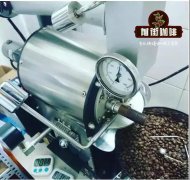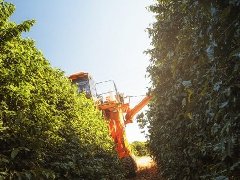What chemical reactions take place in the process of baking beans?

Coffee itself is a kind of plant, how to show its sour, sweet, bitter, salty and other ever-changing flavor? The answer is that the raw coffee beans need to be roasted, that is, the raw coffee beans are heated in the container (roaster, hand net, etc.), and finally reach the appropriate degree of baking. Coffee beans have undergone earth-shaking changes in the roasting process, but it is not as simple as stir-frying the coffee beans.
Before the coffee beans are roasted: the work that must be done is to make the water content inside the raw coffee beans more evenly distributed, which is why the raw beans are put in the warehouse after processing. Only coffee beans with a moisture content of about 12% and a stable state can be exported in coffee trade. Only when the water content of raw beans is uniform can the heat conduction and overall water evaporation be more uniform.
Coffee beans are roasted: there are many chemical changes in the coffee roasting process, and the heated coffee will release its unique aroma like an elf. After coffee is roasted, the beans are brownish in color because of chemical changes in amino acids, chlorogenic acid and sugary substances.
In the process of baking, a large amount of carbon dioxide and water vapor are produced, and the bean cells are rapidly dehydrated and weightless, the density is reduced, and the volume expands. After complex degradation and polymerization, more than 800 chemical components are derived, of which 1/3 are aromatic elves.
Caramelization-carbohydrates or sugars in coffee beans are caramelized at 170-205 degrees Celsius (consistent with the explosion time of coffee beans). After sucrose dehydration, moisture and carbon dioxide are released, and the color of sucrose changes from colorless crystallization to brown. Caramelization gives rise to hundreds of important aromatic substances.
Maillard reaction-proteins account for 11% of the weight of raw beans, and the amino acids that make up proteins also produce important Maillard reactions in coffee roasting. Maillard reaction is not a single chemical reaction, but a series of complex degradation and polymerization of amino acids and reducing sugars such as glucose, fructose, lactose and maltose in the process of continuous heating.
Maillard reaction is different from the temperature requirement of caramelization and can be carried out at room temperature. So why do you keep emphasizing the need for fresh coffee? At present, coffee beans and hanging ear coffee (coffee powder) on the market are marked for more than 8 months or even 18 months. Even if it has been filled with nitrogen and reduced oxygen content, it still can not stop Maillard's reaction. Coffee will be out of breath for too long, and even the secretion of anthocyanins will do great harm to the body.
Coffee sucrose: melting point 187.8 ℃-> sugar? Complex = > caramelization-> water CO2 escapes to produce an explosive First Crack phenomenon. I measured the temperature of the beans in the drum of the baking machine 190 MULFUR 196 ℃.
Cellulose (lignin): coffee cell wall component, resulting in disintegration of cell wall damage at 230℃-> second explosion Second Crack phenomenon I measured bean temperature 211 / 216 ℃ in the drum bean of the roaster.
Trigonelline (Trigonelline): pure crystal 217.9 ℃ begins to degenerate, when bean temperature 192.2 ℃ begins to degrade, when bean temperature 229.4 ℃-> 85% degrades, trigonelline degradation degree (rate) is the key index to determine the best baking reaction ratio.
Therefore, the loss rate (degradation rate) of trigonelline after baking is 50% Mur80%, which is decomposed into a variety of compounds, including non-volatile nicotinic acid and 29 volatile substances, of which 9 are coffee aromatic substances.
Nicotinic acid: coffee raw bean nicotinic acid often exists in cellulose, in the baking process nicotinic acid derived from soluble substances, nicotinic acid derivatives in coffee show good flavor acidity and clean aftertaste (clean finish), so nicotinic acid derivative rate is another index to determine the best reaction ratio of baking.
Ambient temperature (ET): a specific chemical reaction of roasted coffee has a temperature range that produces a good flavor, which is the ambient temperature.
System energy (BTU): the baking process provides the energy BTU gradient (time-heating), which determines the chemical reaction change rate, which is related to the system energy transfer efficiency (STE). There is an optimal reaction rate (BRR), which provides better performance in the coffee cup.
The optimal reaction rate (BRR): there is a linear relationship between the degradation rate of trigonelline and the derivative rate of nicotinic acid when it is concentrated in the ambient temperature (ET). When the baking reaction distribution is different under ET/BTU/STE, the ambient temperature (ET) of the optimal reaction rate (BRR) (ET) is 205 ℃ 218 ℃ by default.
Maximum ambient temperature (MET): when sucrose caramelization reaction begins not to lose temperature, otherwise there will be thermal hysteresis effect, so it is necessary to ensure the temperature of the baking environment to provide system energy transfer for chemical reaction, and too high will cause the optimal reaction rate (BRR) to be too fast, so MET is generally as high as 271℃.
Raw beans will change in two stages after baking.
1 physically = > volume, density, volume
2 chemically = > smell, taste, taste
The violent reactions of coffee beans during high temperature baking include Mena reaction (Maillard reaction), caramelization reaction (Caramelization), Stryker degradation reaction (Strecker degradation), and pyrolysis of various sugars, amino acids and lipids. The aroma of coffee is produced by combining the results of these reactions. Different raw beans, different composition, different baking aroma.
Mena reaction (Maillard reaction)
In 1912, Louis Camille Maillard Camille Mena (1878 murmur1936) discovered that the mixture of amino acids and sugars produced yellowish brown substances after heating the aqueous solution. In memory of Louis Camille Mena (Louis Camille Maillard, 1878 murmur1936), we call this reaction the Mena reaction (Maillard reaction).
Non-enzymatic saccharification (nonenzymatic glycation) or Mena reaction (Maillard reaction) is the reaction of reducing sugars and amines in the absence of enzymes to produce yellowish-brown substances, which are collectively referred to as advanced glycation end products (advance glycation endproducts,AGEs).
Mena reaction (Maillard reaction) is a non-enzymatic browning reaction widely distributed in food industry.
This concept is the vision of baking bread. It is better to say that what you see in life is more associative than the theory of chemistry.
It's like the beef is bloody to the delicious entrance... It looks like three / five / seven / well-done
It refers to reducing sugars and amino compounds, such as free. Amino acid, peptides, protein, amine and other compounds react to form glycosaminoglyco. after Amadori or Heyns translocation, they go through a series of dehydration, condensation and polymerization to form dark brown substance (melanoidins) melanin or melanin. In addition to producing melanoidin, hundreds of intermediate molecules with different odors, including reducing ketones, aldehydes and heterocyclic compounds, are produced in the reaction process, which provide delicious flavor and attractive color for food.
Caramelization reaction (Caramelization)
When sugars are no longer in the presence of amino acids, when heated above the melting point, the sugars will dehydrate and degrade, as well as browning, which is called caramelization.
The concept is caramel sauce under the pudding.
Take two sand and add some water to boil it brown. Don't go too deep. Because it will be bitter.
After baking: roasted coffee beans should be cooled and ripe, and should be placed in a dry and cool place, commonly known as "raising beans".
Important Notice :
前街咖啡 FrontStreet Coffee has moved to new addredd:
FrontStreet Coffee Address: 315,Donghua East Road,GuangZhou
Tel:020 38364473
- Prev

How many stages are there in roasting coffee? What kind of coffee does different roasting degree correspond to?
The roasting method of professional coffee is usually divided into the following eight stages. 1. Very shallow baking (LIGHTRoast): the degree of baking; very shallow baking, also known as shallow baking. The lightest roasting degree of all roasting stages, the surface of the coffee beans is a light cinnamon color, its taste and aroma are insufficient, this state is almost undrinkable. It is generally used for testing and seldom for tasting. 2. Shallow baking
- Next

What role can machinery play in the production of boutique coffee?
Professional coffee knowledge exchange more coffee bean information please follow the coffee workshop (Wechat official account cafe_style) sometimes, it is difficult to separate the concept of boutique coffee from handmade and small-scale things. We believe that human knowledge and care can produce some of the best coffee in the world. This is a human hand, not a machine. There is no denying that human hands are superior to production.
Related
- Beginners will see the "Coffee pull flower" guide!
- What is the difference between ice blog purified milk and ordinary milk coffee?
- Why is the Philippines the largest producer of crops in Liberia?
- For coffee extraction, should the fine powder be retained?
- How does extracted espresso fill pressed powder? How much strength does it take to press the powder?
- How to make jasmine cold extract coffee? Is the jasmine + latte good?
- Will this little toy really make the coffee taste better? How does Lily Drip affect coffee extraction?
- Will the action of slapping the filter cup also affect coffee extraction?
- What's the difference between powder-to-water ratio and powder-to-liquid ratio?
- What is the Ethiopian local species? What does it have to do with Heirloom native species?

